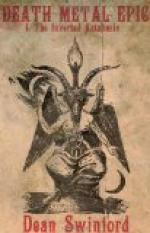At his cries, the prioress hastened to check the bleeding of Robin’s wound, but too late! Faintly whispering he would never hunt in the forest again, Robin begged Little John string his bow, and raise him up so he could shoot a last arrow out of the narrow window, adding that he wished to be buried where that arrow fell. Placing the bow in Robin’s hand, Little John supported his dying master while he sent his last arrow to the foot of a mighty oak, and “something sped from that body as the winged arrow sped from the bow,” for it was only a corpse Little John laid down on the bed!
At dawn on the morrow six outlaws bore their dead leader to a grave they had dug beneath the oak, above which was a stone which bore this inscription:
Here underneath this little stone
Lies Robin, Earl of Huntington,
None there was as he so good,
And people called him Robin Hood.
Such outlaws as he and his men
Will England never see again.
Died December 24th, 1247.
THE FAERIE QUEENE
Edmund Spenser, who was born in London in 1552 and lived at Dublin as clerk to the court of Chancery, there wrote the Faerie Queene, of which the first part was published in 1589 and dedicated to Elizabeth. In this poem he purposed to depict the twelve moral virtues in twelve successive books, each containing twelve cantos, written in stanzas of eight short lines and one long one. But he completed only six books of his poem in the course of six years.
The Faerie Queene is not only an epic but a double allegory, for many of the characters represent both abstract virtues and the noted people of Spenser’s time. For instance, the poem opens with a description of the court of Gloriana,—who impersonates Elizabeth and is the champion of Protestantism. As queen of the fairy realm she holds annual festivals, in one of which the young peasant Georgos enters her hall. He kneels before her so humbly yet so courteously that, notwithstanding his rustic garb, she perceives he must be of noble birth. When he, therefore, craves as a boon the next adventure, Gloriana grants his request, on condition that he will serve her afterward for six years. Shortly after, a beautiful lady, garbed in white but enveloped in a black mantle, rides up to court on a snow-white ass, leading a woolly lamb. She is followed by a dwarf, who conducts a war-steed, on which are piled all the arms of a knight. On approaching Gloriana, Una—the personification of Truth—explains that her royal parents are besieged in their capital by a dragon, which has slain all the warriors who have ventured to attack him.
On hearing Una beg for aid, Georgos eagerly steps forward to claim the task. Ill pleased to be given a peasant instead of the knight she was seeking, Una coldly bids Georgos—the personification of Holiness—try on the armor she has brought, adding that, unless it fits him exactly, he need not expect to triumph. But no sooner has the youth donned the armor which the dwarf produces than all recognize with wonder it must have been made for him, and Gloriana publicly dubs him “Knight of the Red Cross,” because the armor Una brought bears that device.




